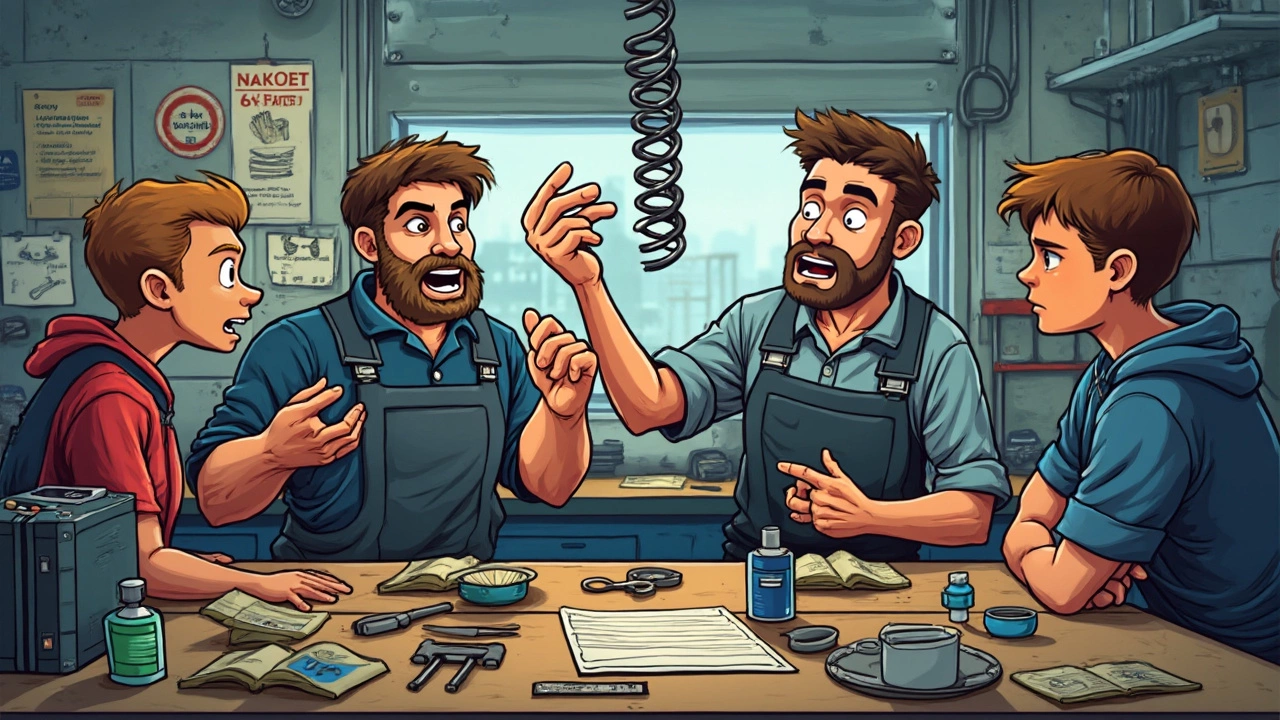Some folks grab an angle grinder and start slicing at coil springs, thinking it’s the quickest way to drop their ride. The goal? A lower stance, maybe a meaner look, and sometimes—just sometimes—hope for tighter handling. But here’s the thing: cutting your springs is like using kitchen scissors to hem a suit—it might look okay for a minute, but it’s rarely a perfect fit and stuff can go wrong fast.
If you’ve ever watched cheap car hack videos online, you’ve probably seen someone do it. But the truth is, there’s a lot more going on under your fenders than you might think. The way your suspension moves, handles bumps, and keeps your tires on the road all depends on the exact shape, length, and strength of those coils. Start chopping, and you could throw all that engineering out the window.
- Why People Cut Springs
- What Actually Happens When You Cut Springs
- Impact on Safety and Ride Quality
- Better Ways to Lower Your Car
- What the Pros Recommend
Why People Cut Springs
Let’s be honest. Most people cut their car’s springs because they want that dropped look without shelling out hundreds for a fancy suspension kit. It usually comes down to saving money while chasing the style you see on cars at local meets or online forums. A lower car can look sharper and hug the road a little tighter around corners, at least in theory. There’s also this rumor that just by chopping a spring or two, you’ll magically get a sportier ride. But is it worth it?
Here are some real reasons drivers take the DIY shortcut:
- Chasing that "slammed" or aggressive stance for cheap
- Trying to improve handling or reduce body roll—especially on older cars with soft suspension
- Quick fix for sagging or tired springs instead of replacing them
- Peer pressure from car friends or online groups boasting about home-brew mods
Plenty of online car communities and Reddit threads show folks swapping stories about their home-cut jobs. But most pro mechanics won’t touch a car with cut springs, mainly because it switches out designed safety and performance for a big box of question marks.
Check out how spring cutting stacks up to other ways people lower cars:
| Method | Average Cost (USD) | Ride Quality | Handling |
|---|---|---|---|
| Cutting Stock Springs | $0 - $50 | Poor | Unpredictable |
| Aftermarket Lowering Springs | $150 - $500 | Good | Consistent |
| Coilover Suspension Kit | $500 - $2000+ | Excellent | Customizable |
If you’re thinking about grabbing the grinder, just remember: saving cash up front can lead to bigger bills later.
When the cutting springs debate pops up, it’s usually about the instant savings. But as you’ll see in the next sections, there’s a lot more at stake than just ride height or style points.
What Actually Happens When You Cut Springs
The moment you slice a coil or two off a spring, you’re not just making it shorter—you’re changing how your whole suspension setup works. Car makers design springs to handle specific weights and bumps, so messing with them throws off that balance. The coil's strength, known as its spring rate, usually goes up after cutting, making the ride stiffer than intended.
Here’s what really goes down:
- cutting springs increases your spring rate, which means less give over potholes and rough roads. You’ll feel pretty much every bump.
- The spring can now sit loose in the strut, which sometimes leads to weird clunking noises or, worse, the spring popping out if you catch some serious air.
- Your tire alignment might go totally out of spec, because parts like control arms and tie rods were set for the factory ride height.
- Chopped springs rarely match up with the shock absorbers’ travel range, which is bad news for ride comfort and tire grip.
Here’s a quick look at what changes inside your suspension when you cut the springs:
| Before Cutting | After Cutting |
|---|---|
| Factory ride height | Lowered ride height |
| Comfortable, controlled ride | Bumpy, harsher ride |
| Proper alignment | Possible misalignment |
| Even tire wear | Increased uneven tire wear |
| Spring fits snug in strut | Spring may move or rattle |
One detail a lot of people miss: springs have a special shape at both ends—usually flattened or "pigtailed" to fit perfectly in their mounts. When you lob off a coil, you usually lose that shape, so the spring can’t sit right anymore. That makes creaky noises inevitable, and sometimes, handling gets sketchy because the spring shifts while you drive.
If you’re thinking it’s a free way to get low, just know the price you’ll pay is in ride quality, safety, and long-term costs. Saving money up front can mean shelling out for tires, alignment jobs, or even suspension repairs down the road.

Impact on Safety and Ride Quality
Cutting your own springs can mess with your safety way more than most people expect. When you shave off a coil or two, the spring gets stiffer but also shorter, making the ride harsh and stiff. You’ll probably feel every bump and pothole in the road. Worse, it changes how well your tires keep contact with the ground, especially over rough roads or during a quick swerve.
Your car’s suspension system is balanced to work with springs that match your shocks and struts. Hack off some coils, and your shocks suddenly have less room to work. That can make them bottom out, which feels and sounds terrible—and puts stress on the rest of your suspension. According to a 2022 survey by a major car safety group, over 80% of vehicles with DIY-cut springs failed basic ride comfort tests compared to cars running factory or aftermarket lowering springs.
Things get sketchier if you like to drive fast. On sharp corners, the altered spring rate makes your car unpredictable. Suddenly, the back end might slide out or the whole car could bounce around, making it crazy hard to control. Even daily driving gets tiring—lots of folks who cut springs end up regretting it after a few months of sore backs and creaky noises every time they hit speed bumps.
Here’s a quick comparison of how cut springs stack up against proper lowering springs and stock springs:
| Spring Setup | Ride Comfort | Handling | Safety | Suspension Life |
|---|---|---|---|---|
| Cut Springs | Poor | Unpredictable | Unsafe | Reduced |
| Proper Lowering Springs | Fair/Good | Better/Stable | Safe | Normal |
| Stock Springs | Best | Normal | Safe | Normal |
The bottom line? If you care about keeping your car on the road and coming home in one piece, cutting springs just isn’t worth the risk. There are safer ways to get the look you want—without turning your daily drive into a crash course in physics.
Better Ways to Lower Your Car
If you're itching for a meaner stance or better handling, you’ve got options that won’t mess up your ride quality or safety. Instead of hacking away at your original springs, check out these tried-and-true methods.
- Lowering springs: These are made for the job. They’re engineered to be shorter and stiffer than your stock springs, keeping suspension geometry in check. Most brands design them to lower your car by about 1 to 2.5 inches, which is plenty without rubbing tires or bottoming out.
- Coilover kits: This option gives you full adjustability—height, damping, and sometimes camber. They’re pricier up front, but you control exactly how your car sits and handles. Daily drivers and track guys both swear by good coilovers.
- Air suspension: Want to go low and still clear speed bumps? Air suspension systems let you drop or raise your ride at the push of a button. These setups are more for show cars or folks who don’t mind spending more.
Here’s how these solutions stack up against just cutting springs:
| Method | Avg. Cost | Ride Quality | Safety | Adjustable? |
|---|---|---|---|---|
| Cutting Springs | $0 (DIY) | Poor | Risky | No |
| Lowering Springs | $150–$400 | Good | Safe | No |
| Coilovers | $700–$2500+ | Great (varies by quality) | Very Safe | Yes |
| Air Suspension | $1,800–$5,000+ | Very Good | Safe | Yes |
If you’re on a budget, lowering springs are the sweet spot. They’re made to last, keep your alignment in check, and won’t leave your car feeling like a pogo stick. Coilovers open up a whole new world for tuning, while air ride is more for those who want total control over stance for both daily cruising and car shows. The big takeaway? Never pick the shortcut that puts you—or everyone else on the road—at risk.

What the Pros Recommend
Professional mechanics and serious car tuners almost never suggest cutting your springs. There’s a reason shops won’t touch this job—it's risky and leads to unpredictable handling. If you really want that lowered look without destroying your ride quality or safety, there are much better ways to do it.
The best route is to buy a proper set of lowering springs made specifically for your car model. These springs are engineered to handle bumps, weight shifts, and hard corners—unlike chopped stock springs, which can mess up your ride height and suspension geometry. A set might run you $150 to $350, depending on your car, but you get peace of mind and a much better driving experience.
Most brands even test their products for miles on tracks and real roads before selling them. Take Eibach, for example—they’re known for rigorously testing spring rates, making sure you won’t scrape every speed bump but can still corner better than stock. Plus, most aftermarket springs fit your stock struts and seats, so you don’t end up twisting or breaking stuff after install.
"Cutting springs is a shortcut with long-term costs. Purpose-built lowering springs or coilovers keep your car safe and enjoyable," — Brian Turner, ASE-Certified Master Automotive Technician, quoted in a 2023 interview with CarThrottle.
Here’s a quick look at how methods compare:
| Method | Cost | Ride Quality | Safety | Lifespan |
|---|---|---|---|---|
| Cutting Springs | $0 - $50 | Poor | Dangerous | Short |
| Lowering Springs | $150 - $350 | Good | Safe | Long |
| Coilovers | $500 - $2000 | Variable (Adjustable) | Very Safe | Long |
If you just want a slight drop and keeping it safe is the goal, lowering springs are the most common pro move. If you want full-on adjustability (ride height, stiffness, and more), then coilovers are the king—invented for racers, but popular on the street too.
Tips from pro installers:
- Always get an alignment after lowering your car. Changes in height will throw off the suspension angles.
- Double-check that new springs are rated for your car’s weight—spring rates matter for both comfort and handling.
- If your shocks are old, replace them at the same time—you won’t have to take your suspension apart twice.
Bottom line: spend a little more up front on the right parts, and you’ll save yourself headaches, repairs, and tow truck rides down the road.




